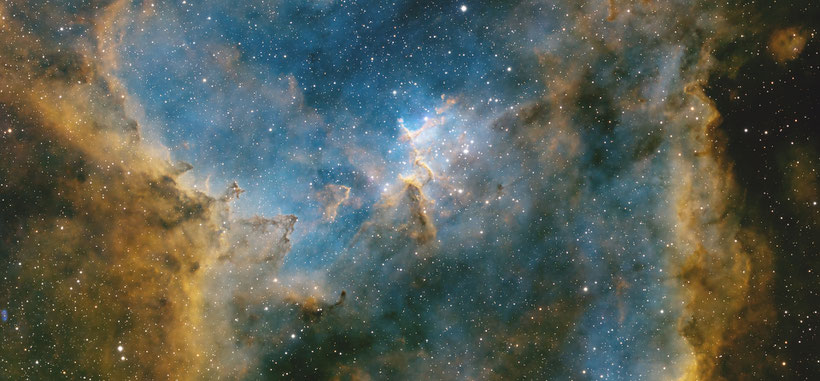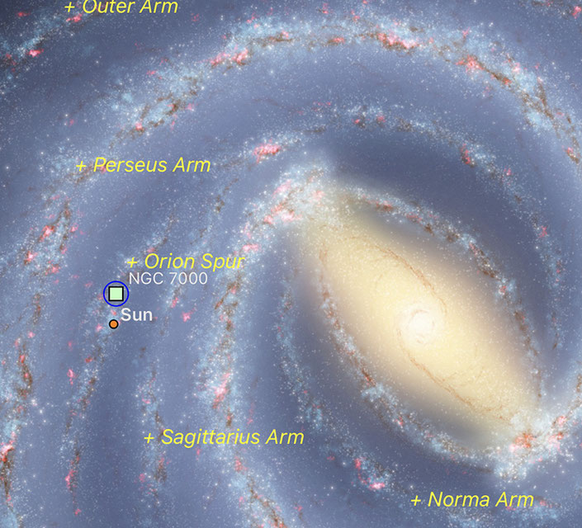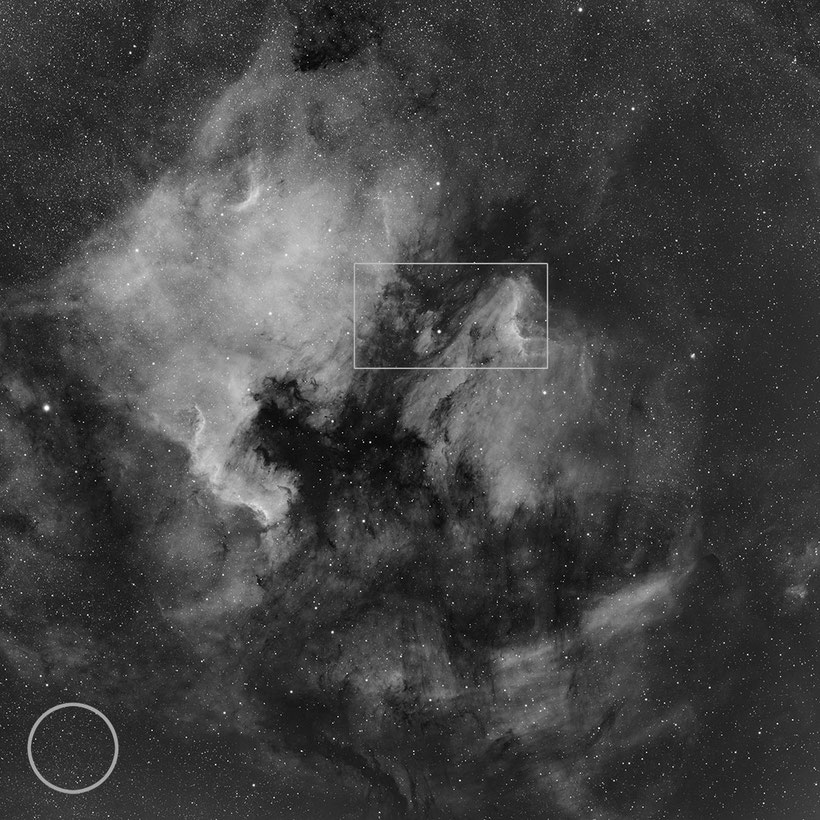Narrow band astrophotography

Open cluster Melotte-15 radiates the Heart Nebula with high-energy ultraviolet light which ionizes hydrogen, oxygen, and sulfur atoms. The elements return this absorbed light only at certain wavelengths. With fine-tuned filters that are transparent only to one of many wavelengths for each element, one can make a photo that shows the ionization of each element, in this case hydrogen, oxygen and sulfur. Although the entire periodic table is present in the nebula, these three elements are the easiest to detect.

The Soul Nebula in Cassiopeia
Taken during two of the rare cloudless nights of the autumn of 2022.
8.5 hours exposure time through Chroma narrowband filters.
H-a 4h 10 min
O-III 2h 40min
S-II 1h 40min
Telescope: Skywatcher Esprit 120, focal length 840 mm, f/7
Drive: Astrosysteme DDM160
Camera: Apogee U16M, CCD temperature = -20 C
Processing: PixInsight
North America- og Pelican nebula
These two halves of a four pane mosaic cover 4.4 x 4.4 degrees on the sky. This is roughly the angular area of a credit card held at arm's length.

Deep inside the Pelican Nebula
Stars are born from collapsing clouds of cold (-250 C) hydrogen. During å span of several thousand years, a young star expels gas jets along its rotation axis. The jets reach velocities of several hundred kilometers per second. These new-born stars are called Herbig-Haro objects. They are named after George Herbig og Guillermo Haro, who described the physics of them in the 1950s.
The Cygnus Wall
The W-shaped Cygnus Wall extends over the middle third of this photo. The Cygnus Wall is a shock front of ionized gas, mainly hydrogen. The intense radiation from young, hot stars provides the pressure that forms the structure, and they provide the energy that ionizes the gas. These newly formed stars are hidden behind the cold, dark gas and dust in the upper middle part of the image.
The image is a detail of only 3.5 % of the wide-field mosaic below (North America and Pelican Nebulae in Cygnus).
The Isle of Rennes (Rennesøy), August - October 2020, 2021 og 2022
Telescope: Skywatcher Esprit ED 120 mm f/7 apochromat
Mount: ASA DDM160
Camera: Apogee U16M, CCD temperature -25 C, processing PixInsight
Exposure: Hydrogen, oxygen and sulfur (H-a, OIII and SII), four individual panes, 15 hours exposure in each pane.
NGC 7000 and IC 5070 (North America- and Pelican Nebula) in Cygnus
The North America and Pelican nebulae are near the zenith during autumn evenings in southern Norway.
This is a 54 megapixel, four-panel mosaic narrowband image of ionized hydrogen (light green), oxygen (turquoise), and sulfur (red). Cold, dark clouds of gas and dust silhouette the fluorescent gas, creating structure.
The young star that is ionizing the nebula, making it fluoresce, is completely hidden behind the cold, dark dust cloud near the center of the image, off the southern tip of “Florida”.
The sharp contrast of ionized gas and cold gas and dust makes this area of the autumn sky one of the most dramatic we can see from Norway's latitudes.
William Herschel documented the nebula in 1786. As early as 1890, the German astrophotographer Max Wolf described the shape of the nebulosity as resembling North America, with outlines reminiscent of Mexico, Yucatán, Florida and the Caribbean.
Fun facts
- The distance to NGC7000 is 2590 ± 80 light years*. The width of the image is 170 light years.
- The digital resolution of the original photo is 7336 x 7336 pixels. Seen from the distance of these nebulae (2590 lightyears), our solar system out to Neptune's orbit would be completely invisible as it would cover only 0.015 pixel.
- The space probe "New Horizons" was launched in 2006 and flew by Pluto over nine years later. One of the fastest space probes, New Horizons currently has a velocity of over 23.2 km (14.4 miles) per second, which equals 84,000 km/time (52,000 m/h). To traverse the width of this photo (170 light years), New Horizons would require 2.2 million years.
- The entire periodic table is present in these nebulae. The elements are formed in stellar cores, merging neutron stars and dying low-mass stars which had existed long before these nebulae had formed.
- The darkest areas in the photo are sufficiently cold to allow molecules to form. Here, the temperature is only -263 C.
Frequently asked questions
-
Are the colors real?
No. The filtration and color pallette show the distribution of three elements: hydrogen, oxygen and sulfur. Human eyes are not light-sensitive enough to see colors in these nebulae, not even through a large telescope. If our eyes were thousands of times more sensitive, we would perceive the color of the nebulae as red or magenta.This is because the strongest emission of ionized hydrogen lies in the red part of the spectrum, and hydrogen is by far the most abundant element.
Isle of Rennes (Rennesøy), August - Oktober 2020, 2021 and 2022
Telescope: Skywatcher Esprit ED 120 mm f/7 apochromat
Mount: ASA DDM160
Camera: Apogee U16M, CCD temperature -25 C, processing PixInsight
Exposure: Hydrogen (H-alpha) 15 hours, double-ionized oxygen (OIII) 20 hours, and single-ionized Sulphur (SII) 12 hours.
Digital resolution of the original photo: 7336 x 7336 pixels
*Kuhn, Michael A.; Hillenbrand, Lynne A.; Carpenter, John M.; Menendez, Angel Rodrigo Avelar (2020). "The Formation of a Stellar Association in the NGC 7000/IC 5070 Complex: Results from Kinematic Analysis of Stars and Gas". The Astrophysical Journal. 899 (2): 128–167.

The location of the North America and Pelican Nebula
On this map of the Milky Way galaxy, the North America and Pelican Nebulae are marked by the light-green square, NGC 7000. The orange dot marks our solar system which lies 2590 light years from NGC 7000, in the same arm of the Milky Way, - the Orion Spur. This section of the map is 50 000 light years on each side.
The pink blobs are star-forming nebulae. New-born stars ionize the nebulae with UV-radiation, and since nebulae are 75% hydrogen, the nebulae glow pink or red.
Same 4-panel mosaic as above, but only the Hydrogen-Alpha wavelength of 656.3nm. The circle at lower left is 1/2 degree in diameter, and shows the apparent size of the moon on the sky for angular scale. The rectangle shows the location of the detail below.

Isle of Rennes, Rogaland, oct 2021
Telescope: Skywatcher Esprit ED 120 mm f/7 apochromat
Mount: ASA DDM160
Camera: Apogee U16M
Exposure / filtering: 120 min / H-alpha, CCD-temp -25 C

Emission nebulae surrounding Sadr (Gamma Cygni)
Isle of Rennes, Rogaland
Telescope: Skywatcher Esprit ED 120 mm f/7 apochromat
Mount: ASA DDM160
Camera: Apogee U16M, CCD temperature -30 C
Exposure: Ha, 15 min

Dinium Observatory
Dinium Observatory is a private backyard observatory on Rennesøy (Isle of Rennes) in south-west Norway. It was built by R.W. Williams, an amateur astronomer and professional paleontologist.
The fiberglass dome is produced by ScopeDome in Poland. The observatory's floorspace is only 8 sqm, yet the dome houses a 62 cm (24 in) cassegrain telescope. The telescope and German equatorial mount have a total mass of 700 kg.
The equatorial mount and truss tube is produced by Astrosysteme Austria (ASA) near Freistadt. The optics are ground and figured on a spindel machine. The truss tube allows the optics to be configured as an f/10.4, 6450 mm cassegrain or a f/3.4, 2108 mm prime focus astrograph. Both foci have large flat-field correctors that yield a 50 mm diameter photographic field.
Left: Although this is Norway's largest optical telescope, the observatory's footprint is small.
Right: Cross-section showing the pyramid-shaped, mechanically isolated concrete pad which is cast and anchored on granitic basement rock. The German-type equatorial mount (560 kg incl. counterweight) is fastened to the concrete pad with expansion bolts. The total mass of the telescope and mount is 700 kg.
Astrophotography and projects.
How does one grind, polish and figure telescope optics at home?
The observatory dome, telescope mount, optical tube assembly and instrumentation.

Fine grinding with a fixed-post grinding machine
The fixed-post polishing tool quickly polished the surface to s sphere, reaching the target center of curvature. The polishing compound was cerium dioxide.

Portland cement polishing tool
The pitch lap is cast as individual squares on the cement tool. Although this method is very time consuming, it avoids the risk of thermal shock to the cellular mirror blank.
So many satellites

We humans have sent many tonnes of technology into orbit from 1957 to the present, - more than 5000 satellites.
During a 4.4 hour exposure covering 6.25 square degrees of sky, many old and new satellites cross the field.
Photo: RW Williams, 8-9 April 2019
Time: 20.55 - 02.28 UT
Equipment: Esprit 120 ED + Apogee U16M
This is mosaic of seventeen lunar images, each of which consists of more than one hundred images stacked and processed in AviStack2. Composited digital resolution is 5200 x 6500 pixels.









